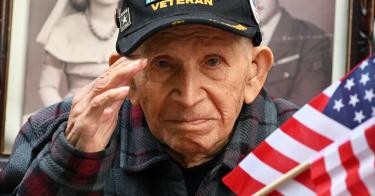During the Civil War, in the summertime, Abraham Lincoln lived in a small cottage on the grounds of the Soldiers and Sailors Home overlooking the capital. From there, he rode back and forth to the White House.
That commute put him in daily contact with Union soldiers being taken to hospitals in the northern part of the city. People would stop and stare as the tall man rode beside the endless train of ambulances carrying the wounded from the Virginia battlefields, “conversing freely with the men.” He constantly asked, “How is at the front” or “How can I help you?”
The Department of Veterans Affairs, launched as a cabinet-level department in 1930, finds its inspiration in Lincoln’s Second Inaugural Address. In what he considered the most important speech he ever delivered—Fredrick Douglass called it “the sacred effort”—an exhausted President, surveying the carnage of America’s most pestilential war; called upon his nation to repent and “…to care for him who shall have borne the battle and for his widow and his orphan ~ to do all which may achieve and cherish a just and lasting peace among ourselves and with all nations.”
>>> On Veterans Day, Let Us Honor Those Who Served as Well as Those Who Stood by Them
In 1956, General of the Army Omar Bradley reported to President Eisenhower on the unique responsibilities of what was then called the Veterans Administration after World War II and Korea. Bradley said: “The Government’s obligation is to help veterans overcome special, significant handicaps incurred as a consequence of their military service. The objective should be to return veterans as nearly as possible to the status they would have achieved had they not been in military service… More stress should also be placed on providing benefits for those who sacrificed most and who need help most.”
Lt. Col. Daniel Gade has taken up Gen. Bradley’s charge. In his new book, Wounding Warriors, Mr. Gade looks at veterans through the eyes of a combat soldier who suffered grievous wounds on the battlefield. He puts the treatment emphasis on those whose wounds are the direct result of combat—Mr. Lincoln’s original purpose for veterans’ services.
In the Trump administration, those with the Purple Heart were given “front of the line” status, even though there were howls from the political classes that all veterans should be treated alike.
It is a common misconception that anyone who puts on the uniform goes in harm’s way. In Vietnam, for every combat soldier, there were at least nine uniforms behind him who did not hear a shot fired in anger. Since 2000, the number exposed to combat represents at most 10 percent of the total force, yet the number of veterans rated at 70 to 100 percent disability has increased sevenfold.
Thirty-six percent of veterans in that same time frame receive disability compensation, compared to 11 percent in World War II and Korea. The system cannot sustain the rate of increase without itself breaking the rest of VA’s vital services, principally direct health care.
Mr. Gade points out the system currently “privileges lifetime disability and malaise over recovery in mental and physical health.” The current system emphasizes driving up the disability ratings for permanent compensation rather than what should be the goal–encouraging all veterans to live up to their “maximum potential.”
The VA presumes permanent disability–not making a veteran whole.
One of the reform points Mr. Gade stresses is that “injuries not caused by direct military service might be targets for treatment instead of compensation”—the goal again being to get veterans healthy and back in the regular flow of society. The current system produces ameliorative cash in lieu of rehabilitative and medical services that veterans should receive first to get back on their feet.
>>> “Wounding Warriors” Authors Highlight Flawed VA Model That Is Letting Veterans Down
The Trump VA reforms began to change the trajectory of VA. The whole veteran became the center of policy, not the prerogatives of the institution. Choice was implemented so that veterans could go where they wanted when they wanted. In the year before COVID-19, suicide levels among veterans declined because new whole approaches were brought online—always emphasizing recovery.
Former Secretary of Defense Gen. Jim Mattis praised Mr. Gade’s work, noting that we can no longer submerge “those with serious problems in a sea of others” who are also lost in a system that allows their “situation to go unimproved.”
Mr. Gade has done the nation an enormous service this Veterans Day. All who have borne the battle should thank him. I know Honest Abe would.
This piece originally appeared in The Washington Times



